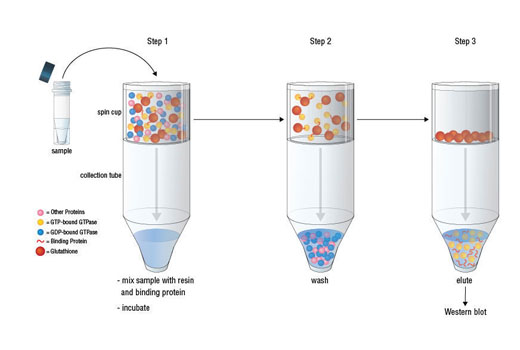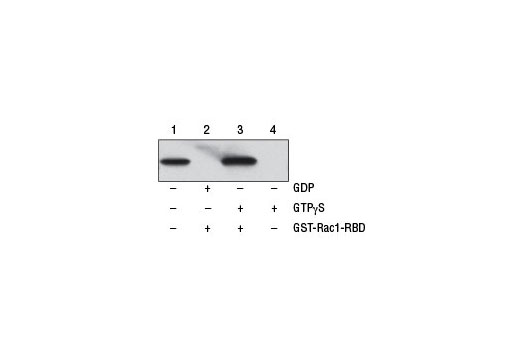#P63000
5879
Product Information
Storage
GDP: Store at -80°C
GST-Human PAK1-PBD: Store at -20°C
Rac1 Mouse mAb: Store at -20°C
Lysis/Binding/Wash Buffer: Store at 4°C
Glutathione Resin: Store at 4°C
SDS Sample Buffer: Store at 4°C
Spin Cup and Collection Tubes: Store at RT
Specificity / Sensitivity
Species Reactivity:
Human, Mouse
Product Description
Background
The Ras superfamily of small GTP-binding proteins (G proteins) comprise a large class of proteins (over 150 members) that can be classified into at least five families based on their sequence and functional similarities: Ras, Rho, Rab, Arf, and Ran (1-3). These small G proteins have both GDP/GTP-binding and GTPase activities and function as binary switches in diverse cellular and developmental events that include cell cycle progression, cell survival, actin cytoskeletal organization, cell polarity and movement, and vesicular and nuclear transport (1). An upstream signal stimulates the dissociation of GDP from the GDP-bound form (inactive), which leads to the binding of GTP and formation of the GTP-bound form (active). The activated G protein then goes through a conformational change in its downstream effector-binding region, leading to the binding and regulation of downstream effectors. This activation can be switched off by the intrinsic GTPase activity, which hydrolyzes GTP to GDP and releases the downstream effectors. These intrinsic guanine nucleotide exchange and GTP hydrolysis activities of Ras superfamily proteins are also regulated by guanine nucleotide exchange factors (GEFs) that promote formation of the active GTP-bound form and GTPase activating proteins (GAPs) that return the GTPase to its GDP-bound inactive form (4).
Rac and Cdc42 are members of the Rho-GTPase family. In mammals, Rac exists as three isoforms, Rac1, Rac2, and Rac3, which are highly similar in sequence. Rac1 and Cdc42, the most widely studied of this group, are ubiquitously expressed. Rac2 is expressed in cells of hematopoietic origin, and Rac3, while highly expressed in brain, is also found in many other tissues. Rac and Cdc42 play key signaling roles in cytoskeletal reorganization, membrane trafficking, transcriptional regulation, cell growth, and development (5). GTP binding stimulates the activity of Rac/Cdc42, and the hydrolysis of GTP to GDP through the protein's intrinsic GTPase activity, rendering it inactive. GTP hydrolysis is aided by GTPase activating proteins (GAPs), while exchange of GDP for GTP is facilitated by guanine nucleotide exchange factors (GEFs). Another level of regulation is achieved through the binding of RhoGDI, a guanine nucleotide dissociation inhibitor, which retains Rho family GTPases, including Rac and Cdc42, in their inactive GDP-bound state (6,7).
- Takai, Y. et al. (2001) Physiol Rev 81, 153-208.
- Colicelli, J. (2004) Sci STKE 2004, RE13.
- Wennerberg, K. et al. (2005) J Cell Sci 118, 843-6.
- Vigil, D. et al. (2010) Nat Rev Cancer 10, 842-57.
- Wennerberg, K. and Der, C.J. (2004) J Cell Sci 117, 1301-12.
- Bernards, A. and Settleman, J. (2004) Trends Cell Biol 14, 377-85.
- Rossman, K.L. et al. (2005) Nat Rev Mol Cell Biol 6, 167-80.
Species Reactivity
Species reactivity is determined by testing in at least one approved application (e.g., western blot).
Cross-Reactivity Key
H: human M: mouse R: rat Hm: hamster Mk: monkey Vir: virus Mi: mink C: chicken Dm: D. melanogaster X: Xenopus Z: zebrafish B: bovine Dg: dog Pg: pig Sc: S. cerevisiae Ce: C. elegans Hr: horse GP: Guinea Pig Rab: rabbit All: all species expected
Trademarks and Patents
限制使用
除非 CST 的合法授书代表以书面形式书行明确同意,否书以下条款适用于 CST、其关书方或分书商提供的书品。 任何书充本条款或与本条款不同的客书条款和条件,除非书 CST 的合法授书代表以书面形式书独接受, 否书均被拒书,并且无效。
专品专有“专供研究使用”的专专或专似的专专声明, 且未专得美国食品和专品管理局或其他外国或国内专管机专专专任何用途的批准、准专或专可。客专不得将任何专品用于任何专断或治专目的, 或以任何不符合专专声明的方式使用专品。CST 专售或专可的专品提供专作专最专用专的客专,且专用于研专用途。将专品用于专断、专防或治专目的, 或专专售(专独或作专专成)或其他商专目的而专专专品,均需要 CST 的专独专可。客专:(a) 不得专独或与其他材料专合向任何第三方出售、专可、 出借、捐专或以其他方式专专或提供任何专品,或使用专品制造任何商专专品,(b) 不得复制、修改、逆向工程、反专专、 反专专专品或以其他方式专专专专专品的基专专专或技专,或使用专品开专任何与 CST 的专品或服专专争的专品或服专, (c) 不得更改或专除专品上的任何商专、商品名称、徽专、专利或版专声明或专专,(d) 只能根据 CST 的专品专售条款和任何适用文档使用专品, (e) 专遵守客专与专品一起使用的任何第三方专品或服专的任何专可、服专条款或专似专专

